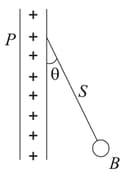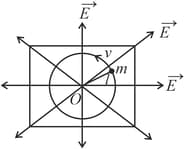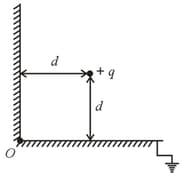Coulomb’s Law : Force between Two Point Charges
Coulomb’s Law : Force between Two Point Charges: Overview
This topic covers concepts, such as, Electrostatic Force between Two Charges in Vacuum, Coulomb's Law, Coulomb's Law in Vector Form, Permittivity of Vacuum, Permittivity of a Medium & Properties of Electrostatic Force etc.
Important Questions on Coulomb’s Law : Force between Two Point Charges
The positive permittivity of the dielectric means is represented as-
Two protons move parallel to each other, keeping distance r between them, both moving with same velocity . Then the ratio of the electric and magnetic force of interaction between them is
Two fixed point charges units are separated by a distance ‘a’. Where should the third point charge be placed for it to be in equilibrium?
How does the coulomb force between two point charges depend upon the dielectric constant of the intervening medium?
Two conducting spheres of radii and are separated by a distance of in free space. If the spheres are charged to same potential of each, the force of repulsion between them is
The centres of two identical small conducting spheres are apart. They carry charges of opposite kind and attract each other with a force . When they are connected by a conducting thin wire they repel each other with a force What is the ratio of the magnitude of charges carried by the spheres initially?
A charge is placed at each of the two opposite corners of a square. A charge is placed at each of the other two corners. If the resultant force on is zero, then
Electric charges of and are placed in air at the corners and respectively of an equilateral triangle having length of each side The resultant force on the charge at is
A charged ball hangs from a silk thread which makes an angle with a large charged conducting sheet as shown in the figure. The surface charge density of the sheet is proportional to

The law, governing the force between electric charges is known as
A bob of mass is tied with a thread and is made to move in a circular path on a horizontal frictionless table about point as shown in the figure. A hypothetical electric field exists in the radial direction along the surface of the table. In this condition, the bob is uncharged and the tension in the thread is . If now the bob is given some charge, then

Two equally charged small metal balls placed at a fixed distance experience a force . A similar uncharged metal ball after touching one of them is placed at the middle point between the two balls. The force experienced by this ball is
Two identical conducting spheres with negligible volume have and charges, respectively. They are brought into contact and then separated by a distance of The electrostatic force acting between the spheres is Given : SI unit
Two small spheres each of mass are suspended from a point by threads long. They are equally charged and repel each other to a distance of Then charge on each of the sphere is The value of will be __________ .
A charge is situated at a distance '' away from both the sides of a grounded conducting '' shaped sheet as shown in the figure.

The force acting on the charge is
The force of attraction between two charges and is . Find the distance of separation (in metre):
A charge exerts force on a second charge If a third charge is brought near, the force of exerted on
As per Coulomb's law, the force of attraction or repulsion between two point charges is directly proportional to the
Two point charges are kept in air with a separation between them. The force between them is , if half of the space between the charges is filled with a dielectric of dielectric constant and the force between them is , if of the space between the charges is filled with dielectric of dielectric constant. Then is
When distance between two-point charges is increased by , the force of interaction
